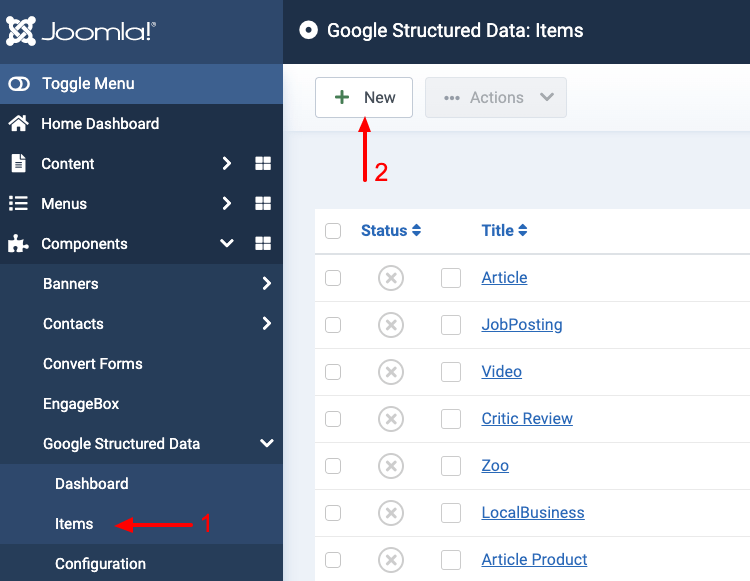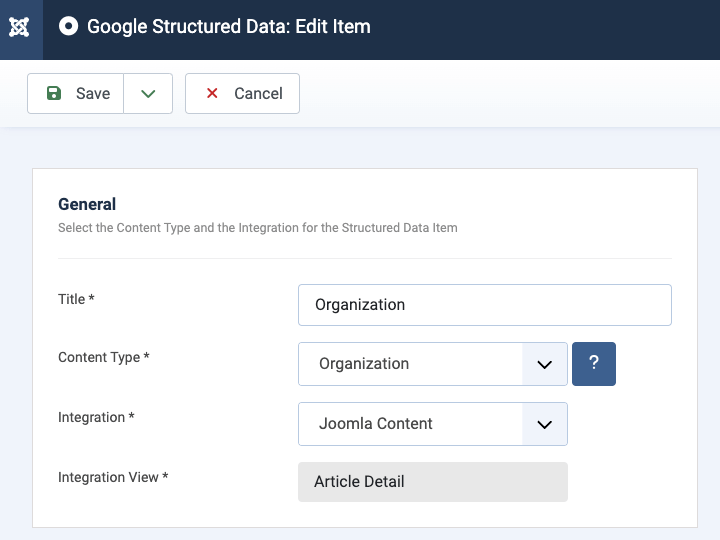-
- Troubleshoot Structured Data not Identified by the Google Rich Results Tool
- Troubleshoot Structured Data not Added to the Page
- Preview button not showing on Structured Data Testing Tool
- I am seeing the "is not a known valid target type for the identifier property" error
- Fixing Error decoding JSON data in Joomla Articles
- Fix missing Google Structured Data tab in the Article Editing Page
- Troubleshoot Structured Data not Showing in Search Results
Organization Structured Data
Add Organization structured data to your Joomla site. Include name, logo, contact info, social profiles, and address to help build your organization's knowledge panel.
The Organization snippet is an essential addition for any business or entity. It helps Google understand your organization's key details and ensures accurate representation in search results. By implementing it, you improve clarity and visibility, preventing confusion with similar organizations. Follow the steps below to set it up
Using the Organization Schema for Website Identity
If you’re using the Organization schema specifically to define your website’s entity—providing details such as name, logo, description, and contact information—it’s recommended to use the Site Representation tab instead of manually creating an Organization item in the Items section.
By selecting Organization in the Site Representation tab, the extension automatically generates the appropriate structured data on your homepage. This section contains all relevant fields, including name, logo, contact details, and address, and should be completed as you would in the Items section.
Using this approach avoids duplicate markup, simplifies configuration, and ensures your homepage is properly structured as your site’s main entity.
Organization vs Local Business Schema
Many website owners struggle to differentiate between Organization and Local Business schemas. While both provide business details to search engines, they serve distinct purposes.
The Organization schema is ideal for companies without a physical location, such as eCommerce stores, virtual services, or parent companies overseeing multiple locations. It helps clarify your brand in search results and provides key details like contact info, policies, and tax IDs.
The Local Business schema is best for businesses with physical locations, ensuring accurate address, hours, and contact details for local search visibility and Google Maps.
In short, use Organization for online businesses or parent companies and Local Business for each physical location to improve search accuracy.
How to markup Joomla Pages with the Organization Schema
From the main menu choose Components -> Google Structured Data. Click on Items from the left sidebar and then on the New button to create a new Structured Data Item.

On the next page, you will need to prepare the Structured Data Item. Enter a Title (it can be anything) and select the Organization Content Type from the respective dropdown.

Next, click to save the Structured Data Item. Once the page reloads, a new section called Organization appears below where you can map each property with page data.

To read more details on how the mapping works, visit the respective section in the How to Add Structured Data to Pages guide.
Supported Organization Types
- Airline: An organization that operates air travel services for passengers or cargo.
- Consortium: An association of two or more entities working together on a joint project or goal.
- Corporation: A business entity recognized as a separate legal entity from its owners.
- EducationalOrganization: An institution that provides education, such as schools, colleges, or universities.
- FundingScheme: A program or initiative that provides financial support to individuals or organizations.
- GovernmentOrganization: A government entity responsible for public administration and services.
- LibrarySystem: A network or collection of libraries operating under a unified system.
- LocalBusiness: A business with a physical presence serving a local community.
- MedicalOrganization: An entity providing medical services, such as hospitals or clinics.
- NGO: A non-governmental organization operating independently from governments.
- NewsMediaOrganization: An entity engaged in publishing news content across various media.
- OnlineBusiness: A business that operates primarily on the internet.
- PerformingGroup: A group engaged in performing arts, such as a band or theater troupe.
- PoliticalParty: An organization aiming to influence government policy and elections.
- Project: A specific initiative or endeavor undertaken by an organization.
- ResearchOrganization: An entity conducting research in various fields.
- SearchRescueOrganization: An organization specializing in search and rescue operations.
- SportsOrganization: A governing body or club involved in sports activities.
- WorkersUnion: An organization representing and advocating for workers’ rights.
Organization Schema Properties
Here's a table of the properties you can define in the Organization Content Type.
| Name | Description |
|---|---|
| Organization Type | Select an Organization Type. |
| Name | The Name of the organization. |
| Logo | The logo of the organization. The image must be 112x112px minimum, crawlable and indexable. It must also have a valid format type, and appear properly on white background. |
| Description | A description of the organization. |
| Website URL | The URL of the organization. |
| Founding Date | The date the organization was founded. |
| Address & Contact | |
| Country | The Country of the organization. |
| Locality | The Locality of the organization |
| Street Address | The Address of the organization. |
| Region | The Region of the organization. |
| Postal Code | The Postal Code of the organization. |
| An email from the organization. | |
| Phone Number | The phone number of the organization. |
| Social Profiles | The URL of a page on another website with additional information about the organization. |
| Organization Identifiers | |
| VAT ID | The VAT ID of the organization. |
| Tax ID | The TAX ID of the organization. |
| ISO 6523 | The ISO 6523 code of the organization. |
| DUNS | The Dun & Bradstreet (DUNS) number of the organization. |
| LEI | The Legal Entity Identifier (LEI) of the organization. |
| NAICS | The North American Industry Classification System (NAICS) code of the organization. |
| Additional Information | |
| Alternate Name | An alternative name for the organization. |
| Legal Name | The legal name of the organization |
| Number of Employees | The number of employees of the organization. |
| Rating Value | The rating value for the content. |
| Reviews Count | How many reviews does this item have. |
Frequently Asked Questions
Should the Organization schema exist on every webpage?
Google recommends adding the Organization schema to your homepage or a dedicated page that describes your organization, such as an About Us page. It does not need to be included on every page of your website.
For best results, use the most specific schema.org subtype that matches your business. For example, a news agency should use NewsMediaOrganization instead of the broader Organization, and a university or school should use EducationalOrganization for better categorization. If your business has a physical location, consider using the LocalBusiness Schema with a relevant subtype instead.
Can I use Organization schema if I’m not a company?
You can use the Organization schema even if you're not a company. It can be used for any entity or group, such as non-profits, educational institutions, or government organizations.
What do you get from implementing the Organization Schema?
Implementing *Organization* structured data helps search engines better understand your organization’s key details, such as its name, contact info, and social profiles. This can improve your visibility in search results, enhance brand recognition, and potentially lead to richer search snippets, like knowledge panels, providing users with more accurate and comprehensive information about your organization.
Why do I see Local Business and Organization Schema in Rich Results Test Tool?
The Rich Results Test Tool may display both Local Business and Organization schema, but this is how the tool interprets the data. Please ignore the Local Business schema and focus only on the Organization schema, as this does not impact search results
Best Practices for Using Organization Schema
Proper implementation of the Organization schema helps search engines understand your organization’s details and improves search visibility. Follow these best practices, aligned with Google's guidelines, to get the most from your schema:
- Place it on relevant pages: Add the schema to your homepage or About Us page.
- Use specific subtypes: Choose the most relevant schema.org subtype (e.g., NGO or EducationalOrganization).
- Include key details: Provide essential information like name, contact details, logo, and social profiles.
- Stay up-to-date: Keep your details current and accurate.
- Test your structured data: Ensure your Organization Schema is correctly implemented using the Google Structured Data Testing Tool.







 Rated:
Rated: 